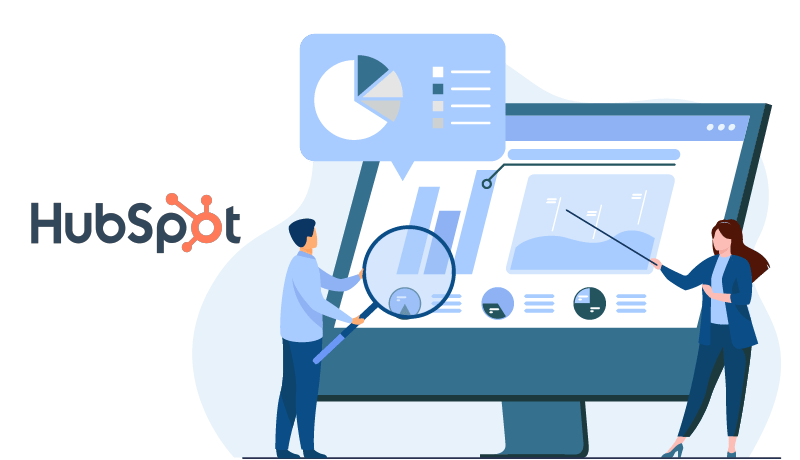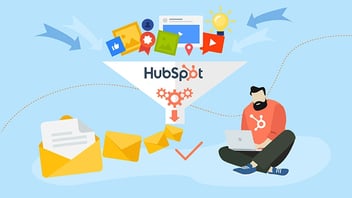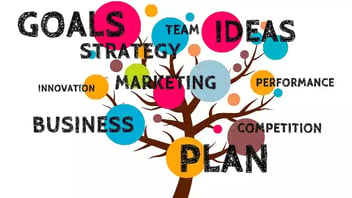Automatisation Marketing: Guide HubSpot
Imaginez un assistant marketing infatigable qui travaille 24 heures sur 24, 7 jours sur 7, envoyant des messages personnalisés, nourrissant les prospects et vous faisant gagner un temps précieux. C'est la magie de l'automatisation du marketing, et des outils comme les flux de travail HubSpot mettent cette puissance à votre portée.
Qu'est-ce que l'automatisation du marketing ?
L'automatisation du marketing est l'utilisation systématique de la technologie pour rationaliser et automatiser les tâches de marketing, en éliminant les efforts manuels et en améliorant l'efficacité opérationnelle. De la génération de leads à la segmentation, en passant par la gestion et l'analyse des campagnes, l'automatisation permet aux spécialistes du marketing de se concentrer sur la stratégie et la créativité, en les libérant du fardeau des tâches répétitives.
Pourquoi l'automatisation du marketing est-elle importante ?
-
L'automatisation du marketing peut augmenter les taux de conversion de prospects de 53 %.
-
Les entreprises qui utilisent l'automatisation du marketing constatent un ROI moyen de 500 %.
-
L'automatisation du marketing peut faire gagner aux équipes marketing jusqu'à 6 heures par semaine sur les tâches répétitives.
L'automatisation accélère le rythme des activités de marketing et garantit la précision et la cohérence. Les processus fastidieux tels que l'email marketing, la publication sur les réseaux sociaux et le lead nurturing peuvent être automatisés, ce qui permet aux équipes marketing d'allouer leur temps et leurs ressources de manière stratégique. Cette efficacité se traduit par une meilleure utilisation des ressources et une amélioration de la productivité globale.
Au-delà de l'automatisation des tâches, l'automatisation du marketing est un catalyseur pour améliorer l'engagement des clients. En exploitant les données et les connaissances, les spécialistes du marketing peuvent créer des communications personnalisées et ciblées qui trouvent un écho auprès de leur public. Les outils d'automatisation permettent de fournir un contenu opportun et pertinent, garantissant que les clients reçoivent des informations adaptées à leurs préférences et à leur comportement.
Les parcours des clients deviennent plus dynamiques et interactifs, ce qui renforce les liens entre les marques et leur public. L'automatisation permet de répondre en temps réel aux interactions avec les clients, créant ainsi une expérience transparente et personnalisée à travers les différents points de contact. Cet engagement accru permet non seulement d'alimenter les prospects, mais contribue également à construire des relations durables avec les clients.
L'avantage HubSpot
Bien qu'il existe d'innombrables outils d'automatisation du marketing sur le marché, HubSpot se distingue. HubSpot est une solution complète conçue pour simplifier et amplifier les efforts de marketing, offrant une plateforme intuitive et puissante qui s'intègre de manière transparente avec les différents canaux de marketing.
Les workflows HubSpot sont le moteur des campagnes marketing automatisées. Ces workflows sont des actions automatisées déclenchées par des événements ou des conditions spécifiques, permettant aux marketeurs de créer des campagnes personnalisées et ciblées à grande échelle. Qu'il s'agisse de lead nurturing, d'email marketing ou d'onboarding client, les workflows HubSpot rationalisent les processus complexes, les rendant accessibles même aux utilisateurs non techniques.
L'attrait de HubSpot réside dans son interface conviviale et ses fonctionnalités robustes qui le distinguent des autres plateformes d'automatisation du marketing.
-
Une plateforme tout-en-un : HubSpot offre une solution tout-en-un qui intègre le CRM, le marketing, les ventes et le service client. Cette intégration transparente permet d'avoir une vision globale des interactions et des données des clients, ce qui permet aux spécialistes du marketing de prendre des décisions éclairées.
-
Personnalisation intelligente du contenu : Les flux de travail HubSpot permettent une personnalisation intelligente du contenu en fonction du comportement de l'utilisateur, garantissant que chaque interaction est adaptée aux préférences individuelles. Ce niveau de personnalisation renforce l'engagement et augmente la probabilité de conversion.
-
Analyses et rapports : HubSpot fournit des outils d'analyse et de reporting complets, permettant aux responsables marketing de suivre les performances de leurs campagnes en temps réel. Cette approche axée sur les données permet d'optimiser et d'affiner en permanence les stratégies de marketing.
-
Évolutivité : HubSpot est conçu pour répondre aux besoins des entreprises de toutes tailles. Que vous soyez une petite startup ou une grande entreprise, l'évolutivité de HubSpot garantit que vos efforts d'automatisation du marketing peuvent se développer en même temps que votre entreprise.
En rationalisant les tâches et en améliorant l'engagement des clients, cette technologie permet aux spécialistes du marketing de naviguer dans les complexités de l'ère numérique avec agilité et précision.
Les principaux composants des flux de travail HubSpot
Les flux de travail HubSpot sont un outil puissant d'automatisation du marketing, permettant aux spécialistes du marketing d'orchestrer des campagnes complexes de manière précise et efficace. Au cœur de cet outil se trouvent trois composants : Les déclencheurs, les actions et les conditions.
Déclencheurs
Les déclencheurs agissent comme des catalyseurs qui mettent les workflows HubSpot en mouvement. Il s'agit d'événements ou d'actions spécifiques qui déclenchent le processus d'automatisation. Comprendre les événements déclencheurs est essentiel pour concevoir des flux de travail qui s'alignent sur le parcours du client. Les déclencheurs les plus courants sont les soumissions de formulaires, les visites de sites web, les interactions par email ou les changements dans les propriétés d'un contact.
Par exemple, lorsqu'un visiteur du site web remplit un formulaire d'inscription, cela peut déclencher un flux de travail qui envoie un e-mail de bienvenue personnalisé, l'ajoute à une liste segmentée et lance une série de communications de suivi. L'identification des bons déclencheurs permet de s'assurer que l'automatisation est lancée aux moments les plus opportuns du parcours de l'acheteur.
Exemples de déclencheurs de flux de travail efficaces :
-
Soumission de formulaire : Déclenchement de flux de travail lorsqu'un utilisateur soumet un formulaire, ce qui indique un intérêt ou un engagement.
-
Interaction par e-mail : Lancement de l'automatisation en fonction des interactions de l'utilisateur avec les courriels, telles que les ouvertures, les clics ou les réponses.
-
Modifications des propriétés du contact : Réponse aux changements de coordonnées ou de comportement, permettant des adaptations dynamiques à l'évolution des profils des clients.
En incorporant stratégiquement des déclencheurs, les spécialistes du marketing peuvent s'assurer que leurs flux de travail automatisés sont opportuns et contextuellement pertinents, contribuant ainsi à une expérience client transparente et personnalisée.
Actions
Une fois déclenchés, les workflows HubSpot facilitent l'exécution d'une série d'actions prédéfinies. Ces actions vont de l'envoi d'e-mails et de la mise à jour des propriétés des contacts à l'inscription des contacts à des campagnes spécifiques ou à la notification des équipes de vente. L'essentiel est de définir une séquence d'actions qui s'aligne sur la stratégie marketing globale et les objectifs particuliers du flux de travail.
Les flux de travail HubSpot permettent aux spécialistes du marketing d'effectuer toute une série d'actions personnalisables. Par exemple, si un contact ouvre un e-mail mais n'effectue pas d'achat dans un délai donné, le flux de travail peut automatiquement déclencher un e-mail de suivi avec une réduction limitée dans le temps. La personnalisation des actions permet d'apporter des réponses sur mesure à divers scénarios, garantissant ainsi l'efficacité et l'adaptabilité de l'automatisation.
Qu'il s'agisse d'entretenir des prospects, d'intégrer de nouveaux clients ou de réengager des contacts inactifs, la flexibilité de la personnalisation des actions permet aux spécialistes du marketing de répondre à différents objectifs par le biais d'un seul flux de travail automatisé.
Exemples d'actions pratiques :
-
Envoi d'un courrier électronique :
-
Déclencheur : Le contact ouvre un e-mail →
-
Action : Envoi d'un courriel de suivi contenant des informations complémentaires ou une offre spéciale.
-
-
Mettre à jour les propriétés du contact :
-
Déclencheur : Le contact soumet un formulaire →
-
Action : Mettre à jour les propriétés du contact pour refléter ses préférences ou son statut, ce qui permet de segmenter et de personnaliser les communications futures.
-
-
S'inscrire à une campagne :
-
Déclencheur : Le contact clique sur un lien spécifique dans un e-mail →
-
Action : Enrôler le contact dans une campagne de marketing ciblée pour le faire progresser en fonction de l'intérêt qu'il a manifesté.
-
Conditions
Les conditions ajoutent une couche d'intelligence aux workflows HubSpot, permettant aux marketeurs d'appliquer une logique et une prise de décision au sein de la séquence d'automatisation. Les conditions agissent comme des filtres, permettant au flux de travail de prendre des chemins différents en fonction de critères spécifiques. Cela permet de créer des parcours clients dynamiques et personnalisés.
En mettant en œuvre des conditions, les spécialistes du marketing peuvent adapter les flux de travail à des parcours clients personnalisés. Par exemple, en fonction du comportement d'un contact, le flux de travail peut s'orienter vers différentes voies de communication - en envoyant du contenu éducatif aux prospects engagés et en proposant des promotions exclusives aux clients à forte valeur ajoutée.
Les conditions permettent aux spécialistes du marketing de répondre de manière dynamique aux interactions avec les clients, en veillant à ce que chaque contact reçoive une expérience unique et pertinente en fonction de son historique d'engagement et de ses préférences.
Exemples de conditions adéquates :
-
Propriétés du contact :
-
Condition : Si le score de lead du contact est supérieur à un certain seuil →
-
Chemin d'accès : Envoyer le contact dans un parcours de lead-nurturing plus agressif avec du contenu et des promotions ciblés.
-
-
Déclencheurs comportementaux :
-
Condition : Si le contact n'a ouvert aucun e-mail au cours des 30 derniers jours →
-
Chemin d'accès : Déclencher une série d'e-mails de réengagement pour ramener le contact dans l'entonnoir marketing.
-
-
Pages vues :
-
Condition : Si le contact a visité des pages de produits spécifiques →
-
Chemin d'accès : Adapter le flux de travail pour fournir des informations plus détaillées sur les produits ou envoyer des promotions ciblées liées aux produits consultés.
-
Comment créer un workflow HubSpot
1. Accéder à l'outil HubSpot Workflow
Commencez par vous rendre sur votre portail HubSpot. Dans le tableau de bord HubSpot, localisez l'onglet 'Automatisation' et sélectionnez 'Workflows'. Cela vous permet d'accéder à l'outil robuste de Workflow qui sert de canevas pour votre chef-d'œuvre d'automatisation.
En entrant dans l'outil de workflow, vous serez accueilli par une interface propre conçue pour une navigation conviviale. La mise en page intuitive permet aux spécialistes du marketing chevronnés et aux novices en matière d'automatisation de naviguer et de créer des flux de travail en toute transparence.
2. Définir les objectifs et les buts
Avant de plonger dans les aspects techniques, il est essentiel de définir clairement les objectifs et les buts de votre flux de travail. Posez-vous la question : Quel est le but de cette automatisation ? S'agit-il d'entretenir des prospects, d'intégrer de nouveaux clients ou de réengager des contacts dormants ? La définition d'objectifs clairs guidera le processus de création du flux de travail et aidera à sélectionner les déclencheurs, les actions et les conditions les plus pertinents.
Pensez aux résultats spécifiques que vous souhaitez obtenir, tels que l'augmentation des taux de conversion, l'amélioration de la satisfaction des clients ou la réduction des cycles de vente. Un objectif bien défini garantit que votre flux de travail s'aligne sur des stratégies de marketing plus larges et contribue de manière significative aux objectifs de l'organisation.
3. Définir les déclencheurs, les actions et les conditions
En gardant vos objectifs à l'esprit, procédez à la mise en place des principaux composants de votre flux de travail.
-
Déclencheurs : Identifiez les événements déclencheurs qui initieront votre flux de travail. Qu'il s'agisse de soumissions de formulaires, d'interactions par courrier électronique ou de modifications des propriétés d'un contact, choisissez des déclencheurs qui correspondent aux objectifs que vous avez définis. Par exemple, si votre objectif est la maturation des prospects, un déclencheur pourrait être le téléchargement d'un livre blanc par un contact.
-
Actions : Une fois le déclencheur activé, décrivez la série d'actions à entreprendre. Il peut s'agir d'envoyer des e-mails, de mettre à jour les propriétés des contacts, d'inscrire des contacts à des campagnes ou d'informer les équipes de vente. Personnalisez chaque action pour vous assurer qu'elle correspond à vos objectifs généraux. Par exemple, si un contact ouvre un e-mail de tarification mais n'achète pas, définissez une action pour envoyer un e-mail de suivi avec une réduction limitée dans le temps.
-
Conditions : Mettez en place une logique conditionnelle pour créer des parcours client dynamiques et personnalisés. Les conditions agissent comme des points de décision dans le flux de travail, permettant aux contacts de suivre différents chemins en fonction de critères spécifiques. Par exemple, si le score d'un contact est élevé, le flux de travail peut l'amener à suivre un parcours de maturation plus agressif.
4. Tester et optimiser les flux de travail
Avant de déployer votre flux de travail, il est impératif de procéder à des tests approfondis pour garantir une exécution sans faille et les résultats escomptés.
-
Prévisualisez et testez : HubSpot propose une fonctionnalité de prévisualisation et de test qui vous permet de simuler le flux de travail et d'évaluer la façon dont les contacts progresseront à travers lui. Cette étape permet de s'assurer que les déclencheurs sont activés correctement, que les actions se déroulent comme prévu et que les conditions guident les contacts à travers les chemins appropriés.
-
Contrôler les analyses : Une fois en ligne, surveillez en permanence les performances de votre flux de travail à l'aide des outils d'analyse et de reporting de HubSpot. Suivez les indicateurs clés tels que les taux d'ouverture, les taux de clics et les taux de conversion. L'analyse de ces mesures fournit des informations sur l'efficacité de votre flux de travail, ce qui permet de procéder à des ajustements et à des optimisations en temps réel.
-
Répétez et améliorez : L'automatisation du marketing est un processus itératif. Revenez régulièrement sur vos flux de travail et affinez-les en fonction des données de performance et de l'évolution des besoins de l'entreprise. Utilisez les tests A/B pour expérimenter des variations et identifier les combinaisons les plus efficaces de déclencheurs, d'actions et de conditions.
Besoin d'aide supplémentaire ? Suivez cette leçon gratuite sur HubSpot !
Meilleures pratiques pour une automatisation efficace du marketing
En ce qui concerne l'automatisation du marketing, le respect des meilleures pratiques est essentiel pour libérer le plein potentiel d'outils tels que les flux de travail HubSpot.
Nourrir les prospects
Créer des campagnes de maturation de prospects ciblées
Il est essentiel d'adapter les campagnes de maturation des prospects aux besoins et aux intérêts spécifiques de votre public. Segmentez vos prospects en fonction de leurs caractéristiques démographiques, de leur comportement ou de leur historique d'engagement.
Créez des séquences de contenu ciblées qui guident les prospects à travers l'entonnoir de vente, en fournissant des informations précieuses à chaque étape. Les flux de travail HubSpot vous permettent d'automatiser la diffusion de ces campagnes personnalisées, garantissant des interactions opportunes et pertinentes.
Maximiser l'engagement des clients
Au-delà de la capture initiale des prospects, l'engagement durable des clients est vital. Utilisez les flux de travail HubSpot pour automatiser les stratégies d'engagement, telles que les campagnes de goutte-à-goutte, les courriels déclenchés et la livraison de contenu personnalisé.
En comprenant le comportement et les préférences de votre public, vous pouvez créer des flux de travail dynamiques qui s'adaptent à leur parcours, favorisant un engagement continu et augmentant la probabilité de conversion.
Personnalisation
Élaborer des contenus et des messages personnalisés
La personnalisation ne se limite pas à s'adresser aux clients par leur prénom. Exploitez vos données pour créer des contenus qui résonnent avec chaque segment de votre audience. Utilisez les flux de travail HubSpot pour alimenter dynamiquement les e-mails et les pages de renvoi avec des informations personnalisées, en veillant à ce que votre communication soit adaptée et pertinente. Le contenu personnalisé améliore l'expérience du client, ce qui se traduit par un engagement plus fort et une plus grande fidélité à la marque.
Adapter la communication en fonction du comportement du client
La mise en œuvre de déclencheurs et de conditions basés sur le comportement est cruciale pour une personnalisation efficace. Les flux de travail HubSpot vous permettent de suivre et de répondre aux interactions des clients en temps réel. Par exemple, si un contact s'intéresse régulièrement au contenu vidéo, automatisez les flux de travail pour fournir davantage de matériel vidéo.
En adaptant votre communication aux comportements individuels, vous démontrez que vous comprenez les préférences de vos clients, ce qui vous permet de renforcer vos liens et d'accroître l'impact de vos efforts marketing.
Les flux de travail HubSpot : La clé de l'automatisation du marketing
Les outils polyvalents de HubSpot permettent aux responsables marketing de rationaliser les processus marketing et de s'adapter à l'évolution des besoins des clients. Le déploiement stratégique des workflows HubSpot apparaît comme un catalyseur clé pour atteindre un succès durable et favoriser des relations durables avec les clients.
Ce contenu est disponible en:
- Allemand: Was ist Marketing-Automatisierung: Wie man HubSpot-Workflows verwendet
- Anglais: What is Marketing Automation: How to Use HubSpot Workflows
- Espagnol: Automatización de marketing: Guía de flujos de trabajo en HubSpot
- Italien: Automazione Marketing: come usare i workflow di HubSpot
- Roumain: Automatizare marketing: Cum să folosiți fluxurile de lucru HubSpot
- Chinois: 什么是营销自动化?如何使用 HubSpot 工作流程










Commentez ci-dessous